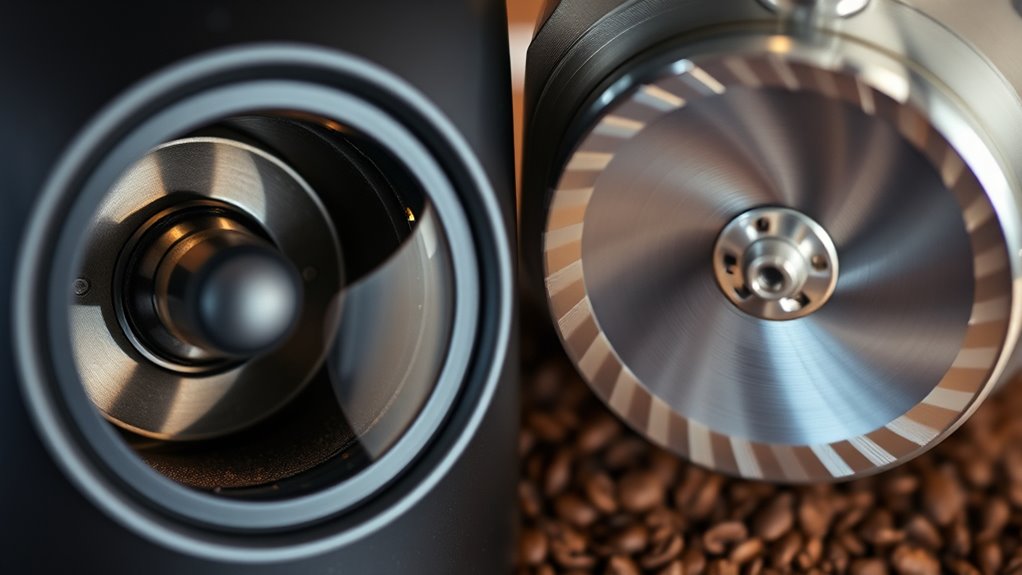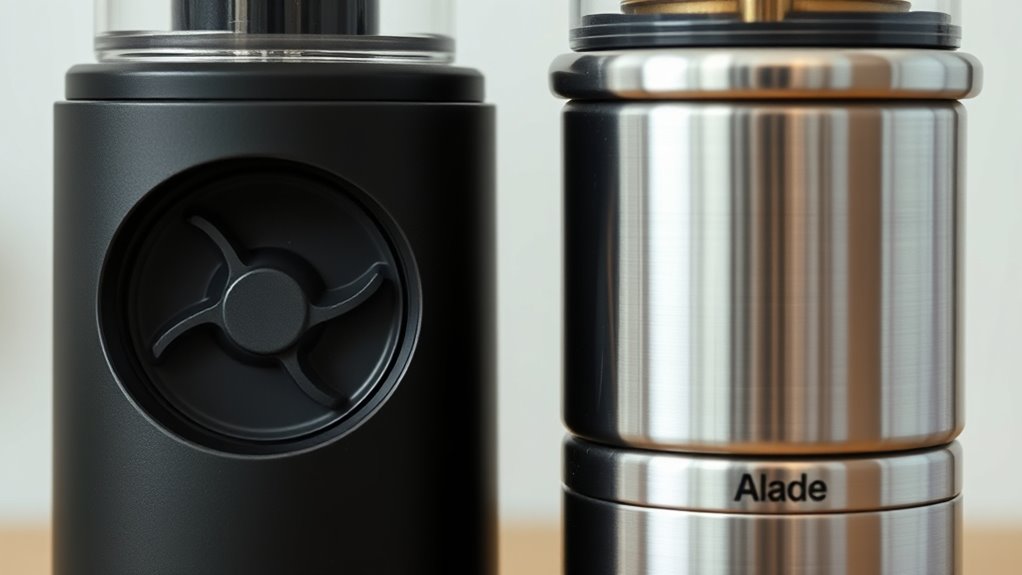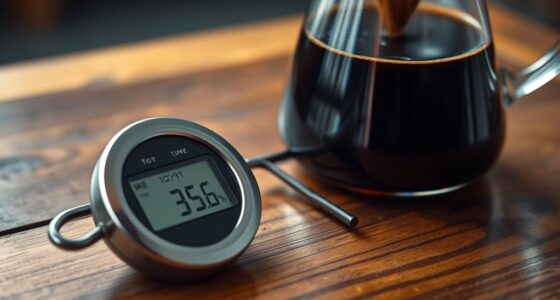When choosing between burr and blade grinders, you should know that burr grinders use two abrasive surfaces to produce consistent, uniform grounds, which is ideal for flavorful brewing, while blade grinders chop beans unevenly, leading to inconsistent results. Burr grinders offer better control over grind size and preserve aroma, making them perfect for serious coffee lovers. Blade grinders are cheaper and simpler but can compromise flavor. Keep exploring to discover how each option fits different brewing styles and preferences.
Key Takeaways
- Burr grinders crush beans between two abrasive surfaces for consistent, uniform grounds, ideal for precise brewing methods.
- Blade grinders chop beans with spinning blades, producing uneven grounds that can affect flavor and extraction.
- Burr grinders offer adjustable grind sizes and better control, enhancing flavor, aroma, and brewing versatility.
- Blade grinders are typically less expensive, simpler to use, but may lead to inconsistent grind sizes.
- For optimal coffee quality and flavor consistency, burr grinders are preferred over blade grinders.

When choosing a coffee grinder, understanding the different types is vital for achieving the best flavor and brewing results. The two main grinder types are burr grinders and blade grinders, each offering distinct advantages and drawbacks.
Burr grinders use two abrasive surfaces to crush coffee beans into ground coffee, producing a uniform grind that’s essential for peak extraction. The consistency of the grind directly influences flavor, as an uneven grind can lead to over-extraction or under-extraction, resulting in a less balanced cup. Burr grinders come in two primary styles: conical and flat burrs.
Conical burr grinders typically generate less heat during grinding, helping preserve the beans’ aromatic qualities, making them ideal for home use. Flat burr grinders, on the other hand, provide a highly uniform grind, especially favored for espresso brewing, but tend to be louder and consume more energy.
Blade grinders operate differently by chopping coffee beans with rapidly spinning blades. While they’re generally less expensive and more straightforward to use, they often produce inconsistent results. The blades cut the beans unevenly, which results in grounds of varying sizes.
This inconsistency can negatively impact brewing quality, especially with methods that require precise extraction, like pour-over or espresso. The uneven grounds can cause over-extraction of some particles and under-extraction of others, leading to a brew that lacks clarity and balance.
Because blade grinders don’t produce a uniform grind, they’re less suitable for brewing methods that depend on consistency for peak flavor. Choosing between burr and blade grinders depends on your preferred brew methods and how much importance you place on grind consistency.
If you’re serious about flavorful coffee and want to maximize the potential of your coffee beans, a burr grinder is the better choice. It offers a uniform grind, whether you prefer conical or flat burrs, and can be adjusted to match your brewing method—be it French press, drip, or espresso.
For casual coffee drinkers or those on a budget, blade grinders might suffice, but keep in mind they compromise on grind uniformity and overall quality. Ultimately, your decision will affect not only the flavor and aroma of your coffee but also the ease and consistency of your brewing process.
Additionally, grind size plays a crucial role in determining the extraction level and overall flavor profile of your coffee, making it a key consideration when choosing a grinder type.
Frequently Asked Questions
What Is the Difference Between a Burr Grinder and a Regular Grinder?
When you ask about the difference between a burr grinder and a regular grinder, you’re looking at how each processes coffee beans.
A burr grinder crushes beans evenly for a consistent grind, giving you better flavor and extraction.
In contrast, a regular grinder, often a blade type, chops beans unevenly, leading to inconsistent grounds.
Burr grinders cost more but offer precision, while regular grinders are simpler and less expensive.
Which Is Not an Advantage of Using a Burr Grinder?
You want to know which isn’t an advantage of a burr grinder. While burr grinders offer consistent grind size, preserve flavor, and allow precise adjustments, their main downside is cost.
They tend to be more expensive upfront compared to other grinders. If you’re on a tight budget or just starting, this higher price mightn’t seem like an advantage, making it less appealing despite their many benefits.
What Is the Advantage of a Burr Grinder?
You benefit from a burr grinder because it produces uniform coffee grounds, which leads to more consistent extraction and better flavor. With adjustable settings, you can precisely control the particle size for different brewing methods.
Plus, burr grinders generate less heat, preserving aroma and taste. They’re durable and designed for long-term use, ensuring you get a smoother, balanced coffee experience every time you grind.
Is a Burr Grinder Better Than a Blade Grinder?
You’re wondering if a burr grinder is better than a blade grinder. Generally, yes. A burr grinder gives you more control over grind size, ensuring consistent grounds that improve flavor. It also produces less heat, preserving aroma, and lasts longer.
While it costs more upfront, the quality of your coffee and durability make it a worthwhile investment, especially if you’re serious about brewing the perfect cup.
Conclusion
In the end, choosing between a burr and a blade grinder depends on your priorities. If you want consistent, flavorful grounds and don’t mind a higher price, go for a burr grinder. But if you’re on a budget and need something quick, a blade grinder works fine. Consider your brewing style and how much effort you want to invest. Whichever you pick, you’ll enjoy better coffee with the right grinder by your side.









